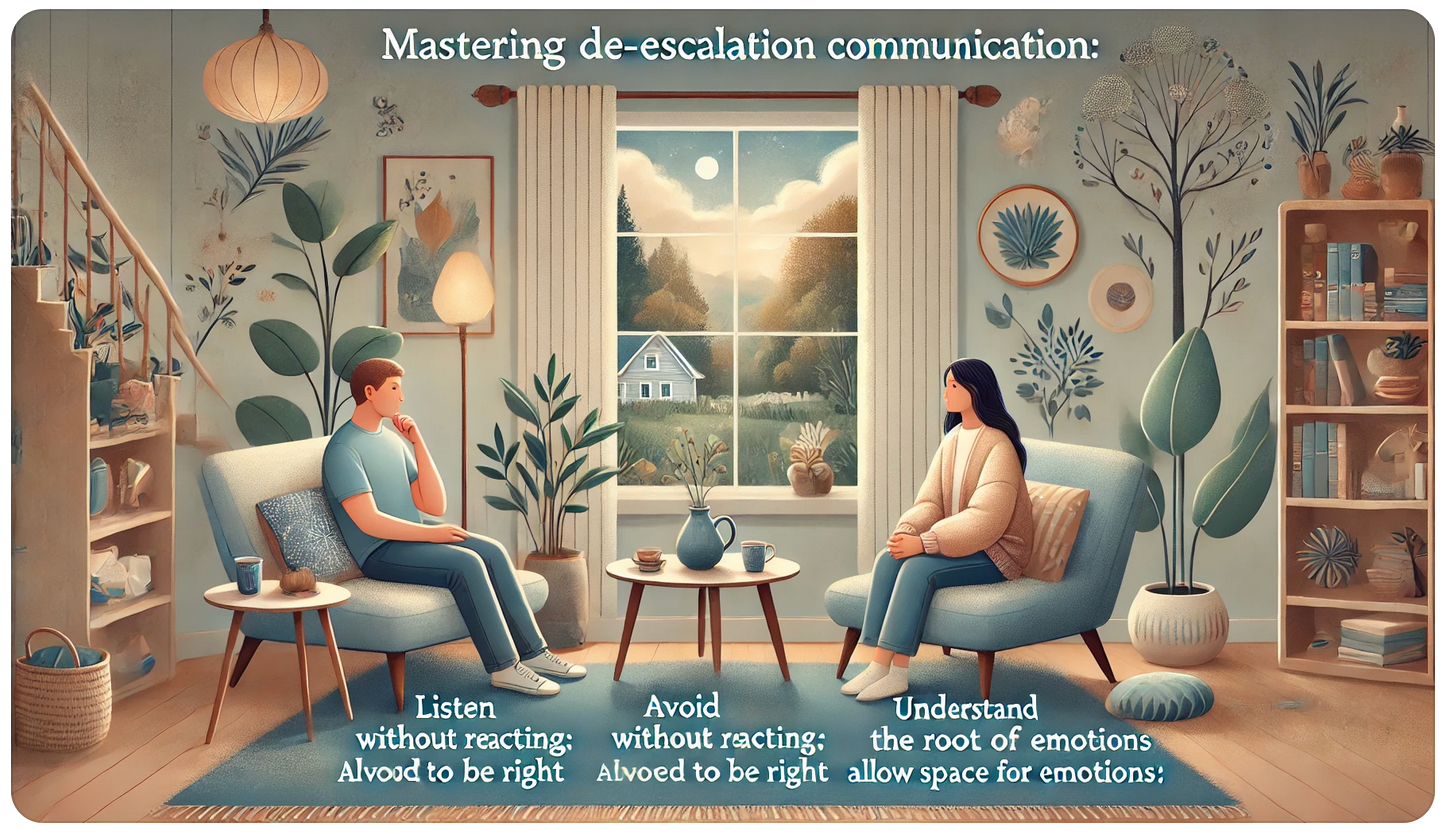Conflict is an inevitable part of any relationship, but the way we handle it can make all the difference. De-escalation communication is a powerful tool that allows us to navigate conflicts with grace and compassion. By listening fully, avoiding the need to be right, and understanding the deeper roots of emotional eruptions, we can foster healthier and more fulfilling relationships. Here’s a closer look at how to master the art of de-escalation.
Listen Without Reacting
One of the most important aspects of de-escalation is listening without reacting. When someone is expressing their grievances, it’s crucial to listen fully without immediately trying to correct or defend. This helps to diffuse tension and allows the other person to feel heard and validated.
Tip: Practice active listening by nodding, maintaining eye contact, and repeating back what the other person has said to ensure you understand their perspective.
Avoid the Need to Be Right
Engaging in a battle to be right or to inflict damage is counterproductive and drains energy. The goal is to understand and empathize, not to win an argument. Letting go of the need to be right can create space for genuine connection and resolution.
Tip: Focus on understanding the other person’s feelings rather than formulating your next rebuttal. This shift in mindset can transform the dynamics of the conversation.
Understand the Root of Eruptions
Emotional outbursts often stem from deeper issues like pain, hurt, guilt, and regret. Recognizing this helps in responding with empathy rather than defensiveness. An eruption is a signal that something significant needs to be addressed.
Tip: When faced with an emotional outburst, try to identify the underlying feelings and address those rather than the surface issue.
Allow Space for Emotions
Both partners need space to express their emotions. The challenge arises when both need to vent simultaneously, necessitating careful navigation and mutual respect. Allowing each other the space to express emotions without interruption can lead to a more constructive dialogue.
Tip: If both parties are emotionally charged, agree to take turns speaking and listening without interruption. This ensures that both voices are heard.
Strategies for Effective De-escalation
Self-De-escalation
Before attempting to de-escalate a situation with someone else, ensure you are calm and centered. This might involve taking a moment alone to reflect and breathe. Self-de-escalation allows you to approach the conversation with a clear and composed mind.
Tip: Practice deep breathing exercises or take a short walk to calm your mind before engaging in a difficult conversation.
Setting Boundaries
Clearly communicate your boundaries from a place of centeredness. If the other person is not listening, it’s okay to take a step back and revisit the conversation later. Boundaries help protect your emotional well-being and create a safe space for dialogue.
Tip: Use “I” statements to express your boundaries, such as “I feel overwhelmed and need some time to process before we continue this conversation.”
Practicing Self-Love
When feeling rejected or disrespected, focus on self-love and self-care. Recognize your worth and validate your own feelings. Self-love provides a solid foundation from which you can navigate conflicts more effectively.
Tip: Engage in activities that nurture your well-being, such as reading, meditating, or spending time in nature.
Taking Time and Space
Allowing time and space for both yourself and the other person can help in processing emotions more healthily. Don’t rush the process; let it unfold naturally. Time and space can provide the clarity needed to approach the situation with a fresh perspective.
Tip: If a conversation becomes too heated, suggest taking a break and revisiting the topic after some time to cool down and reflect.
Neutral Communication
Strive to communicate from a neutral place, especially if emotions are high. This might mean temporarily distancing yourself to cool down before re-engaging in the conversation. Neutral communication helps prevent further escalation and promotes understanding.
Tip: Use calm and neutral language, and avoid accusatory or inflammatory statements. For example, say “I feel” instead of “You always.”
Reflective Responding
Respond thoughtfully rather than react impulsively. Ensure your responses are aligned with love and care, even when discussing difficult or hurtful topics. Reflective responding allows for more constructive and empathetic communication.
Tip: Before responding, take a moment to consider how your words might affect the other person. Aim to respond in a way that fosters connection and resolution.
Practical Applications
Feeling Disrespected
Clearly articulate what you feel comfortable doing and what you don’t, without letting emotions take over. If not respected, take some space and then readdress the issue. Setting clear boundaries and expressing your needs calmly can prevent misunderstandings.
Example: If your partner criticizes your actions, calmly explain your perspective and set a boundary. “I understand you want things done a certain way, but I feel disrespected when criticized. Let’s find a way to work together.”
Feeling Rejected
Focus on self-love and avoid seeking validation from the other person in moments of rejection. Communicate your feelings once you’ve had time to process them. Self-love strengthens your resilience and helps you approach the situation with clarity.
Example: If your partner rejects a gesture of affection, take a moment to practice self-love. Later, express your feelings calmly: “I felt hurt when you turned away. Can we talk about what’s going on?”
Dealing with Perceived (or Real) Betrayal
Take a step back to assess the situation objectively. Seek clarity through calm and measured communication, and only then decide on the appropriate course of action. Objective assessment helps you respond thoughtfully rather than react impulsively.
Example: If you suspect betrayal, take some time to gather your thoughts. Approach the conversation with a calm demeanor and seek clarity: “I’ve noticed some changes and feel concerned. Can we discuss this openly?”
Conclusion
De-escalation communication is about fostering understanding and compassion, both towards oneself and others. By giving time and space, practicing self-love, and communicating from a place of neutrality, you can navigate conflicts more gracefully. Trusting in the process and accepting reality as it is, rather than forcing it to conform to your expectations, will lead to more harmonious relationships and personal peace.
Embrace these strategies and insights to transform your approach to conflict, creating a foundation for healthier and more fulfilling interactions. Remember, the art of de-escalation is a journey of self-awareness, empathy, and love.

